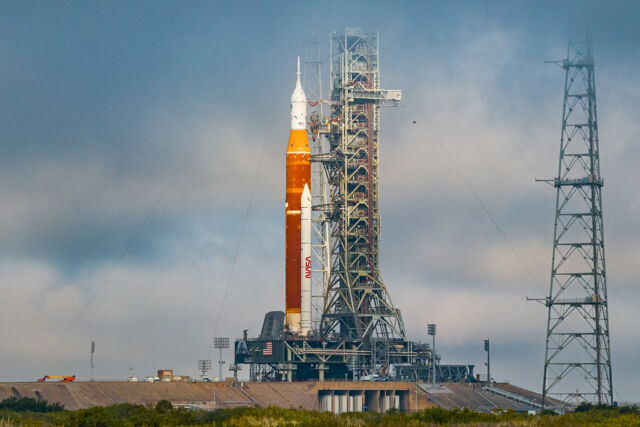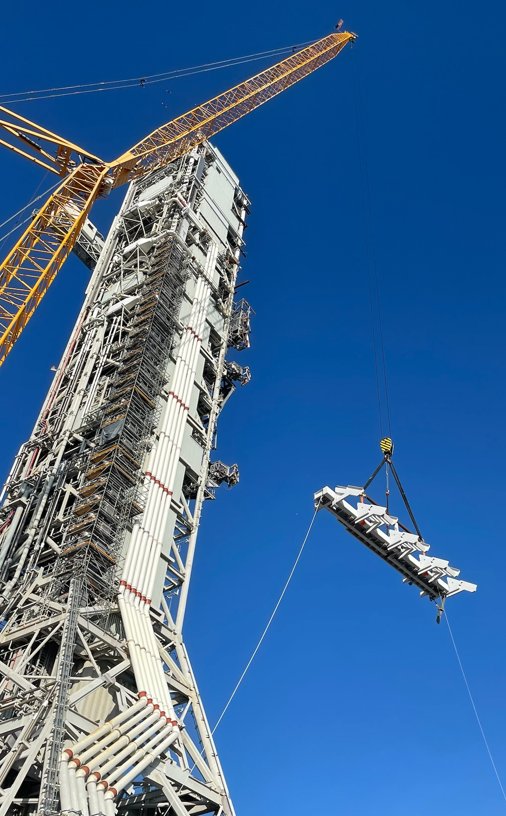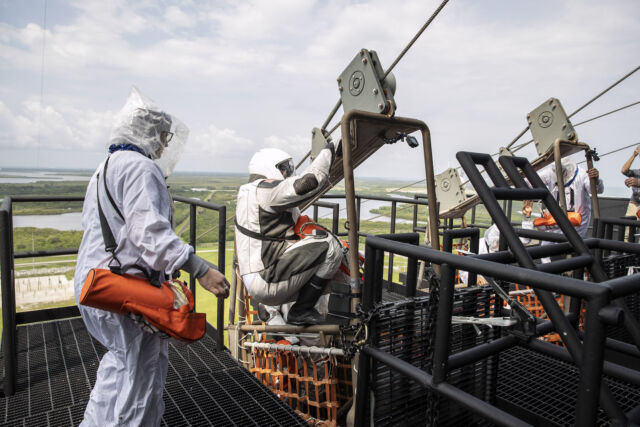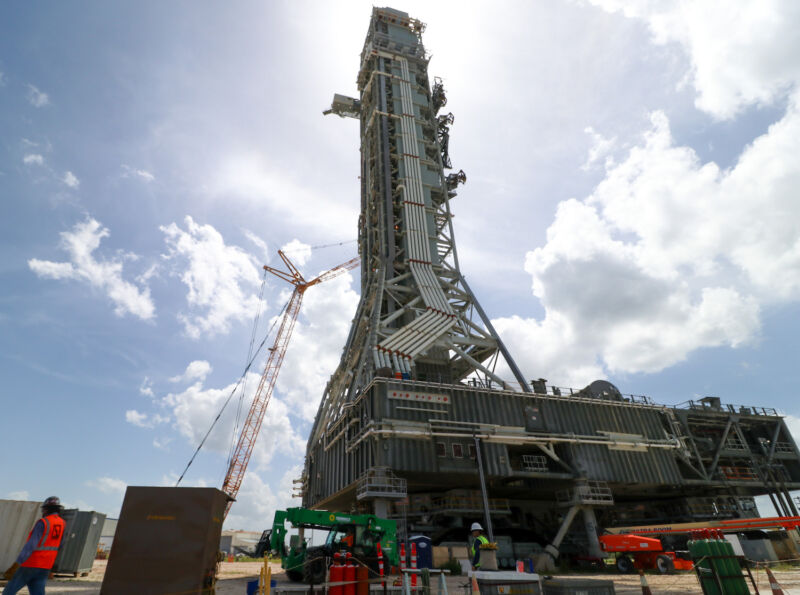“We’re getting back into testing, which is what we love."
NASA's repaired and upgraded mobile launch platform moved back to its launch pad at the Kennedy Space Center this week. This marks a transition from refurbishment after the launch of the Artemis I mission last year into preparations for Artemis II—the Moon program's first flight with astronauts.
The giant structure sustained more damage than expected during the first launch of NASA's Space Launch System rocket last November. The 380-foot-tall (116-meter) launch tower has been parked just north of the iconic Vehicle Assembly Building since January, undergoing repairs and modifications to prepare it for its next use on Artemis II.
That work is now largely complete, and NASA's Apollo-era crawler-transporter began moving the launch platform back to Launch Complex 39B on Wednesday for about four months of testing. Then, if all goes well, NASA will declare the structure ready for stacking of the SLS Moon rocket for Artemis II.
“What’s the mood? I think folks are really ready to get back into pad operations," said Jeremy Parsons, deputy manager of NASA's exploration ground systems program at Kennedy. "They’re really ready to get back into stacking. It’s been a push, but I can’t be more proud of them.”
NASA is using the $1 billion launch platform for its first three Artemis missions. This is the structure that the rocket sits on during launch preparations, moving the vehicle between its assembly building and its seaside launch pad at Kennedy. Assembly of a separate, larger, more expensive tower is finally underway at the Kennedy Space Center for missions starting with Artemis IV in the late 2020s.
After launching from Florida on the SLS rocket, the Artemis II mission will carry four astronauts on a loop around the far side of the Moon. The crew members will ride inside NASA's Orion spacecraft for the roughly 10-day flight, the first time people will have traveled to the vicinity of the Moon since 1972.
The Artemis II test flight will set the stage for more ambitious flights to the Moon, with eventual human landings at the south pole and construction of a mini-space station called Gateway in lunar orbit.
Looking ahead to Artemis II
We'll discuss the details of the mobile launcher upgrades later in this story, but first, let's preview how NASA hopes the Artemis II launch campaign will proceed next year.
Jim Free, who oversees NASA's Artemis Moon program, said last week that preparations for the Artemis II mission are a few weeks behind schedule from the agency's target launch date in November 2024. That's no big surprise, and Ars has reported a slip into 2025 is likely.
But NASA hasn't officially given up on November 2024. Parsons told Ars this week that the ground processing team in Florida is looking for efficiencies in the Artemis II launch campaign to counter delays in the Orion spacecraft, the readiness of which is now driving the launch schedule. This Orion capsule will debut new life-support systems, cockpit displays, and controls that didn't fly on the unpiloted Artemis I mission last year.
In broad strokes, here's a look at the timeline over the next year or so.
-
August: Mobile launcher rolls to Launch Complex 39B for testing
-
September: Pre-fueled solid rocket booster segments arrive at Kennedy Space Center by rail from Northrop Grumman's Utah assembly site; Orion crew and service modules are mated at Kennedy to begin integrated tests
-
November: SLS core stage ships to Kennedy from the Michoud Assembly Facility in Louisiana
-
December/January: Mobile launcher returns to Vehicle Assembly Building to prepare for stacking
-
February: Stacking of the solid rocket boosters begins on the mobile launcher
-
April: Core stage is stacked in between the solid rocket boosters; Orion spacecraft is handed over to ground processing team for fueling
-
May: Interim cryogenic propulsion stage is stacked on top of the core stage
-
Mid-2024: Orion spacecraft is fueled and launch abort system is installed before moving to the Vehicle Assembly Building for stacking
At this point, the launch campaign planning becomes a little more fuzzy, currently boiling down to when the Orion spacecraft will be ready for lifting on top of the SLS rocket.
NASA's preferred plan is to stack the rocket in the assembly building while ground teams in a separate facility at Kennedy fuel the Orion spacecraft, add the launch abort system, and install protective aerodynamic fairings around the vehicle. The complete rocket can then go through a fueling test, or wet dress rehearsal, at the launch pad before NASA moves into the real countdown.
“In terms of flow, where I want to be is I want to have the boosters, core stage, and (upper stage) stacked, and then I’m ready for Orion," Parsons said. "It comes on, and then ideally, if you’ve got all of that sequence just right, you could roll out, you do a single wet dress rehearsal, and then go right into launch.
“It probably won’t work out that way. It depends," Parsons said. "We’re protecting for any number of scenarios if Orion takes a little bit longer or we’re having issues."

The SLS rocket and Orion spacecraft are seen before the Artemis I launch.
Trevor Mahlmann
One option is to roll the Space Launch System out to the launch pad in what Parsons called a "short stack" configuration without the Orion spacecraft on top, then load cryogenic propellants into the rocket for the wet dress rehearsal. In that scenario, the rocket would return to the assembly building for the Orion spacecraft to be attached, followed by another sequence of tests before rolling back to the pad for launch.
"I think the optimal plan would be we take Orion, we go out to the pad, do a single wet dress rehearsal, and then launch," Parsons said.
“No decision has been made on that and won’t be made until the fall," he said. "We’re letting some of the schedules mature, and we’re protecting for both options because we want to be able to keep that launch date as much as possible.”
NASA performed several wet dress rehearsals—"wet" refers to the loading of liquid propellants—on the first SLS rocket before the Artemis I mission. Those practice runs were plagued with hydrogen leaks, which continued to dog the Artemis launch team on the mission's first real launch attempt last August.
Finally, engineers changed the way they loaded the cryogenic fuel into the massive core stage, devising a "kinder, gentler" approach to ramping up pressures and flow rates into the rocket. The goal was to prevent seals from unseating in the hydrogen umbilical between the core stage and the mobile launch platform. That worked in November when NASA was able to fill up the rocket and successfully launch it for the first time.
Parsons said the same fueling procedure NASA settled on for Artemis I will be replicated on Artemis II. Engineers are also making some changes to the umbilical connection.
"We had a couple of leaking areas, some of them on the flight side and some of them on the ground side," he said. "Everything on the ground side, we are making more robust with very simple sorts of design changes—welding connections and removing additional flanges where they’re unnecessary."
The Artemis II wet dress rehearsal will allow the launch team to refine the countdown timeline, which will be different from Artemis I because the astronauts will need to board the Orion spacecraft after the rocket is fully fueled.

The white room at the end of the crew access arm will connect to the hatch of the Orion spacecraft.
Stephen Clark/Ars Technica
One complication in NASA's Artemis launch planning is a requirement from the US Space Force's Eastern Range, the entity that oversees public safety during launches from the Florida spaceport. The range requires the rocket's flight termination system, which would be activated to destroy the vehicle if it flew off course, to be tested using its own batteries within 15 days of launch. Currently, that test is only possible when the Space Launch System is still inside the Vehicle Assembly Building before it rolls to the launch pad.
Parsons said NASA is now studying ways to service the flight termination system while the SLS rocket is on the launch pad. Assuming everything else is ready, that could allow NASA to shift from a dress rehearsal directly into a real launch attempt without returning the rocket to the assembly building.
"It's about a 15-day requirement right now, so if you go do a wet dress rehearsal (and then try to launch), you’re going to bust that timeframe," Parsons said. "So we would either need to seek to be able to redo the test out at the pad or seek some sort deviation from the range."
Repairs and upgrades
The mobile launcher took a beating from the blast wave of the SLS rocket's 8.8 million pounds of thrust last year.
A carefully choreographed sequence of umbilical retractions and swing arm movements worked perfectly—timed to the millisecond, Parsons said—to clear out of the way of the Artemis I Moon rocket as it climbed off the launch pad.
But the vibrations from the launch were higher than predicted. That slightly buckled the tower's elevator shafts, requiring repairs before ground teams could restore the elevators back to operation. NASA is adding structural stiffeners to the elevators to avoid a repeat of this problem on Artemis II.
“It definitely exceeded what our initial estimations were," Parsons said. "What we're really looking at is hardening designs and stuff like that. I expect that to be, on a recurring basis, maybe 30 days of the work (after a launch). This ended up taking you four months-plus.”
The mobile launcher lost its supply of gaseous nitrogen during the launch. That system was supposed to activate fire suppression and a wash-down of the tower after liftoff. "Basically, a line broke inside of the mobile launcher," Parsons said.
"Because we didn’t get the wash-down, say, within the first 12 hours, the (booster exhaust) residue stuck around and caused more corrosion than we expected," Parsons said. “So what we ended up having to do more than anything was replace a whole lot of pneumatics lines. These are very thin-walled lines, you’ve got quarter-inch tubing, and so that residue just ate through it really, really quickly.”
Technicians replaced any of the lines that appeared like they might be corroded, totaling about 15,000 feet of tubing, according to Parsons. They also replaced blast decks on the lower platform of the mobile launcher.

Ground teams recently installed a platform for the
mobile launcher's emergency egress baskets.
NASA
Those repairs weren't planned going into the Artemis I launch, but there was some work NASA knew had to be completed on the mobile launcher between the first two Artemis missions.
Chief among these tasks was installing platforms for the emergency egress system, which wasn't on the mobile launcher's tower for Artemis I. Technicians also replaced a bearing on the crew access arm, where the Artemis II astronauts will walk from the tower to enter the hatch of the Orion spacecraft. With these changes in place, the four Artemis II astronauts and up to 14 members of the ground support crew will be able to evacuate the launch pad in less than two-and-a-half minutes in the event of a pre-launch emergency.
In such a case, the astronauts, wearing flame-resistant pressure suits, would exit the Orion spacecraft's hatch and dart across one level of the tower, then climb into baskets designed to slide down cables to a terminus about a quarter-mile west of the launch pad. The crew members could then escape the launch pad area in an armored vehicle supplied to NASA by the US Army.
The setup is similar to the slidewire baskets used on the space shuttle program and at SpaceX's launch pad. Once the SLS mobile launch platform arrives at the launch pad this week, technicians will connect the cables for the slidewire system from the ground to the egress platform near the top of the tower. Then the ground team will hoist four baskets along the cables to their park positions on the tower for a series of drop tests.
The Artemis II astronauts will be at Kennedy this fall for training, including familiarization with the launch pad's egress system. The astronauts will put on their orange pressure suits for some of these activities, according to Parsons.
“They’ll do a demonstration of what is it like to travel from crew quarters to the pad," Parsons said. "So they’ll use the new crew transport vehicles. They’ll make sure everything works well, and we’ll also make sure that they’re familiar with the emergency egress training while that’s going on.”

Astronauts train on the slidewire escape system at SpaceX's launch pad at NASA's Kennedy Space Center.
Currently, the astronauts aren't expected to actually ride the baskets during training. During the final minutes of the real launch countdown, the Orion spacecraft's launch abort rocket would pull the capsule and the crew inside away from the launch pad if there's an imminent risk of an explosion.
Other activities at the launch pad this fall will include swing tests of the crew access arm, which must be able to move from its launch position back to the Orion spacecraft's hatch in less than 45 seconds to facilitate a quick escape for the astronauts inside.
NASA's ground systems team in Florida will also start filling a new 1.25-million-gallon liquid hydrogen tank at Pad 39B. This new tank, which NASA says is the largest hydrogen reservoir in the world, will be tied in with the pad's existing 1960s-era hydrogen tank to allow for launch attempts on back-to-back days, an improvement over the turnaround time of a few days between Artemis I launch attempts. That's important because flights to the Moon come with schedule limitations—Artemis launch dates are only available about two weeks per month.
Toward the end of the year, NASA will test the dual-tank manifold and flow the super-cold liquid hydrogen through transfer lines up to the base of the mobile launcher. Flow checks of the launch pad's sound suppression water system are also on tap later this year, along with tests of upgrades to the launch pad's environmental conditioning system.
“We’re getting back into testing, which is what we love," Parsons said. "We’re engineers. We love to test.”
The goal is to complete these tests within about four months, allowing the mobile launcher to roll back to the Vehicle Assembly Building in late December or early January, in time for the projected start of stacking of the Artemis II rocket in February.
Source



3175x175(CURRENT).thumb.jpg.b05acc060982b36f5891ba728e6d953c.jpg)




Recommended Comments
There are no comments to display.
Join the conversation
You can post now and register later. If you have an account, sign in now to post with your account.
Note: Your post will require moderator approval before it will be visible.